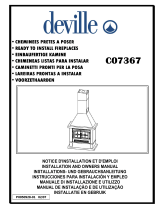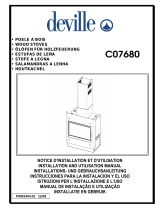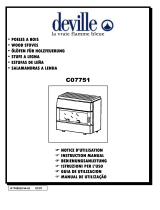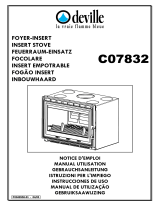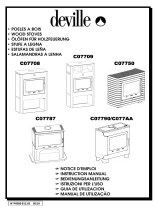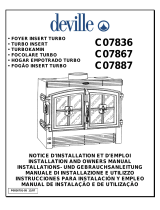
19
• Reload on glowing embers of approximately :
o 0,5 kg for C07335
o 0,3 kg pour C07342
(i.e. 3 cm thickness) with the air intake set to
close position.
5.4.2.2 -
Fire duct
• The desired burn rate is obtained by moving the
air intake control lever (see paragraph 5.3) and
by selecting a load in relation to your specific
needs :
- For maximum heating, load the fireplace with
3 logs measuring approximately 10 cm in
diameter (air intake set to normal position)
(Fig. 14).
Use this position only temporarily, to heat the
rooms following prolonged absence.
- For an intermediate burn rate, reduce the
load : one or two logs (air intake set to middle
position) (Fig. 14).
- For a long-lasting heat output with a slow
combustion rate, use 1 or 2 non-split logs with
a diameter superior to 15 cm (air intake set to
close position) (Fig. 14).
• To get a long-lasting combustion rate, reload on a
merely burning bed of embers.
• For rapid restarting of the fire, add some kindling
wood, load the logs, and only if necessary keep
the door partly open for several minutes, without
leaving the appliance unattended. Thereafter, use
the controls as per the instructions (paragraph
5.4). Doing so will accelerate the fire's recovery,
particularly if the wood is damp.
• Make burn rate changes (passing from a normal
to a reduced burn rate, for example) before
reloading the fireplace during the "live coals"
combustion phase, in order to allow the fireplace
and the chimney flue to adapt progressively to the
change.
• To avoid smoke and falling ash coming out into
the room during reloading operations, the door
should be opened with the following precautions :
- Open the door partly, waits for the open door
suction to start, and open the door slowly.
• Using the stove in continuous mode and a slow
combustion rate, especially in milder temperature
conditions (bad draught) and with wet timber,
leads to an incomplete combustion and the
formation of tar and soot deposits :
- Alternate operation with periods of slow
burning and normal burning.
- Burning small loads is recommended.
• After the stove has been used in slow combustion
mode, the front glass may darken because of a
slight soot deposit, this deposit will burn off (by
pyrolysis) with the next hot fire (higher
combustion rate).
The fitting of a suction moderating flap in the
connecting duct enables to control the burning,
notably slow burning, enabling long lasting
heating.
5.4.2.3 – Set fan (only for C07342)
- DESCRIPTION
(Fig. 24)
The blower unit includes the following :
- a box
- a fan support with a 230 V 50 Hz 30 W
motor fan
- a fan shield
- a selector with two speeds and stop
For the versions with thermostat :
- a thermostat which sets in motion the
ventilator in accordance with the fireplace's
temperature, if the selector is in position I
or II.
- a selector AUTO/MANU
- UTILIZATION
Select a speed of ventilation :
. Little speed, selector in position I
. High speed, selector in position II
Put in heating the apparatus (see the handbook
Fireplace / Insert).
For the versions with thermostat, select automatic
operation (AUTO) or manual operation (MANU)
with the selector :
- In the MANU position : the fan is switched on
and off by manual control. In this position, the
blower function can be started up immediately
and must be switched off by hand.
- In the AUTO position : the fan is operated
automatically, when the whole of the apparatus is
warm, generally during the following hour the
lighting. Its running is interrupted when the
apparatus is cold, generally at the fireplace's
extinction.
If you want the blower to be started up immediately
and then switched off automatically, select the MANU
position when lighting and then switch to the AUTO
position once the appliance is hot. The blower will
then be switched off automatically.
5.4.2.4 - Ash removal
• The air used for the combustion of the wood
arrives underneath the grate when the air intake
control lever is open. This air is also used to cool
the grate. To ensure optimum performance and
to avoid damaging the grate due to overheating, it
is very important that it not be obstructed. The
grate should therefore be cleaned regularly and
the ashes removed.
• Use the scraper to de-ash the grating (Fig. 16).




















